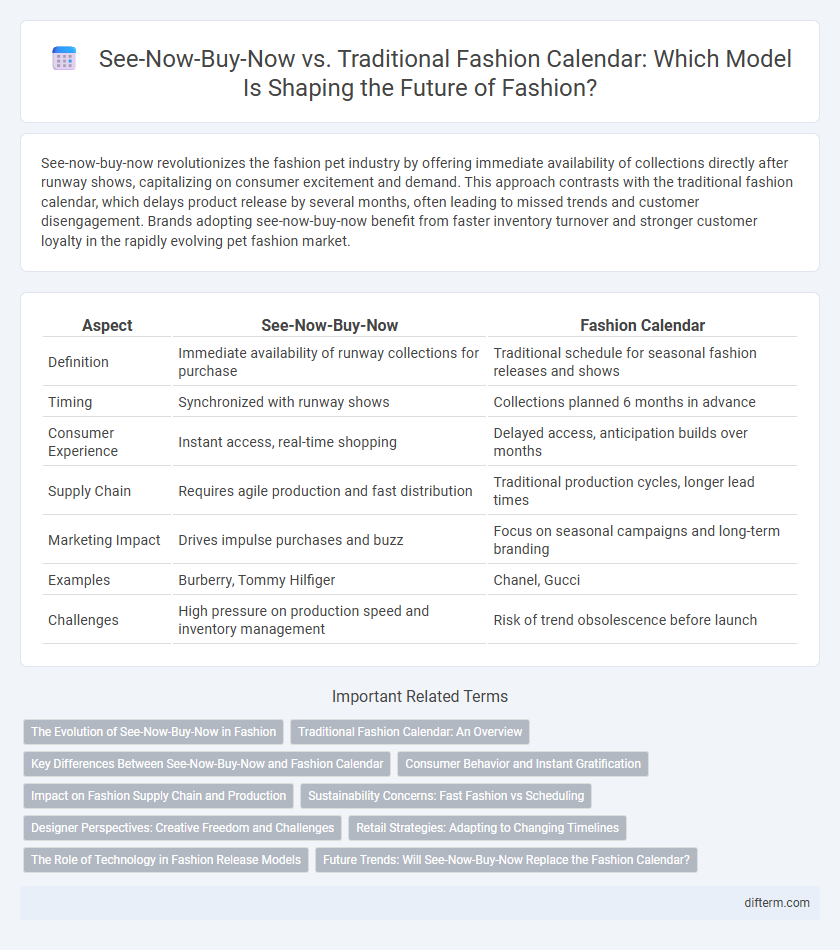See-now-buy-now revolutionizes the fashion pet industry by offering immediate availability of collections directly after runway shows, capitalizing on consumer excitement and demand. This approach contrasts with the traditional fashion calendar, which delays product release by several months, often leading to missed trends and customer disengagement. Brands adopting see-now-buy-now benefit from faster inventory turnover and stronger customer loyalty in the rapidly evolving pet fashion market.
Table of Comparison
| Aspect | See-Now-Buy-Now | Fashion Calendar |
|---|---|---|
| Definition | Immediate availability of runway collections for purchase | Traditional schedule for seasonal fashion releases and shows |
| Timing | Synchronized with runway shows | Collections planned 6 months in advance |
| Consumer Experience | Instant access, real-time shopping | Delayed access, anticipation builds over months |
| Supply Chain | Requires agile production and fast distribution | Traditional production cycles, longer lead times |
| Marketing Impact | Drives impulse purchases and buzz | Focus on seasonal campaigns and long-term branding |
| Examples | Burberry, Tommy Hilfiger | Chanel, Gucci |
| Challenges | High pressure on production speed and inventory management | Risk of trend obsolescence before launch |
The Evolution of See-Now-Buy-Now in Fashion
See-now-buy-now has revolutionized fashion by shortening the traditional six-month gap between runway shows and retail availability, enabling instant consumer access to collections. This approach leverages digital platforms and social media to drive immediate demand, aligning production and marketing with real-time consumer preferences. The shift challenges the established fashion calendar, pushing brands to adopt agile supply chains and respond swiftly to market trends.
Traditional Fashion Calendar: An Overview
The traditional fashion calendar revolves around seasonal collections showcased months before retail availability, allowing designers and buyers to plan production and marketing strategies well in advance. This model emphasizes runway shows during distinct fashion weeks, typically occurring biannually, to present Spring/Summer and Fall/Winter collections. While it ensures a structured timeline for trend anticipation, it often results in a delay between runway debut and consumer purchase.
Key Differences Between See-Now-Buy-Now and Fashion Calendar
See-now-buy-now offers immediate consumer access to runway collections, bypassing the traditional delay imposed by the fashion calendar, which schedules product availability months after shows. The fashion calendar aligns with seasonal marketing and production cycles, emphasizing anticipation and exclusivity, while see-now-buy-now prioritizes instant gratification and rapid turnover. Key differences lie in consumer engagement speed, inventory management, and the balance between trend immediacy versus seasonal planning.
Consumer Behavior and Instant Gratification
See-now-buy-now disrupts the traditional fashion calendar by offering immediate availability of runway items, catering to consumers' increasing demand for instant gratification. This shift influences consumer behavior by accelerating purchase decisions and heightening expectations for fast access to trends. Retailers leveraging see-now-buy-now strategies benefit from increased impulse buying and stronger engagement with time-sensitive consumers.
Impact on Fashion Supply Chain and Production
See-now-buy-now disrupts the traditional fashion calendar by accelerating the entire supply chain, enabling immediate consumer access to runway collections and consequently requiring faster production cycles. This shift increases pressure on manufacturers and suppliers to shorten lead times, manage inventory more dynamically, and enhance real-time responsiveness. The impact on the fashion supply chain includes challenges in maintaining quality control and sustainability standards while meeting heightened demand speed and flexibility.
Sustainability Concerns: Fast Fashion vs Scheduling
See-now-buy-now disrupts traditional fashion calendars by accelerating product availability, reducing overproduction and waste commonly linked to fast fashion cycles. Rapid consumer access encourages sustainable consumption by aligning production closely with actual demand, minimizing inventory surplus. Conversely, conventional fashion calendars risk fostering excess stock and environmental strain due to extended production timelines and speculative ordering.
Designer Perspectives: Creative Freedom and Challenges
Designers balancing see-now-buy-now and traditional fashion calendar models face distinct creative freedoms and challenges, as the former demands rapid production cycles that can constrain innovation while the latter allows for meticulous development but risks delayed consumer engagement. See-now-buy-now enables immediate market response and relevance, yet pressures designers to sacrifice conceptual depth for speed. Conversely, the fashion calendar supports runway artistry and trend forecasting but may reduce direct consumer impact due to the extended gap between show and availability.
Retail Strategies: Adapting to Changing Timelines
Retail strategies are evolving as brands adopt see-now-buy-now models, enabling consumers to purchase runway items immediately and accelerating inventory turnover. This approach challenges the traditional fashion calendar by compressing design-to-shelf timelines, enhancing market responsiveness and reducing risks of unsold stock. Fashion retailers integrating real-time data analytics optimize production and marketing efforts, aligning with consumer demand for instant accessibility.
The Role of Technology in Fashion Release Models
Technology revolutionizes fashion release models by enabling the see-now-buy-now approach, allowing consumers to purchase runway items instantly through digital platforms. Advanced data analytics and AI-driven forecasting optimize inventory and demand management, bridging the gap between seasonal fashion calendars and real-time consumer trends. This integration accelerates product turnaround and enhances customer engagement by aligning production cycles with immediate market feedback.
Future Trends: Will See-Now-Buy-Now Replace the Fashion Calendar?
See-now-buy-now models accelerate consumer access to collections by enabling immediate purchase post-runway, challenging the traditional fashion calendar's seasonal schedules. This shift responds to growing demand for instant gratification and real-time trends-driven commerce, driven by social media and influencer impact. Despite its popularity, the fashion calendar remains essential for production cycles, influencer collaborations, and global market coordination, suggesting a hybrid approach is the future of apparel retail.
see-now-buy-now vs fashion calendar Infographic

 difterm.com
difterm.com